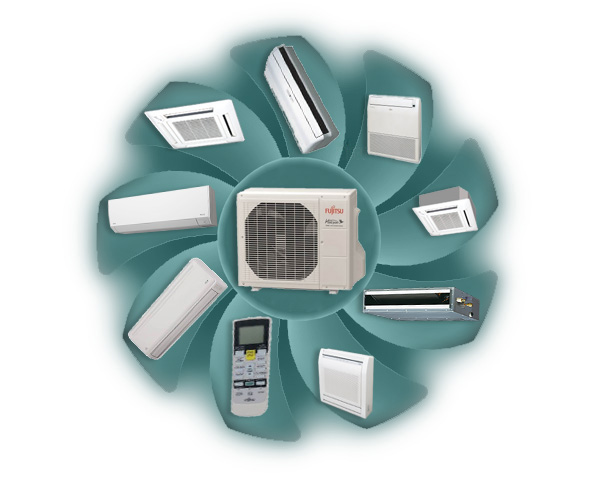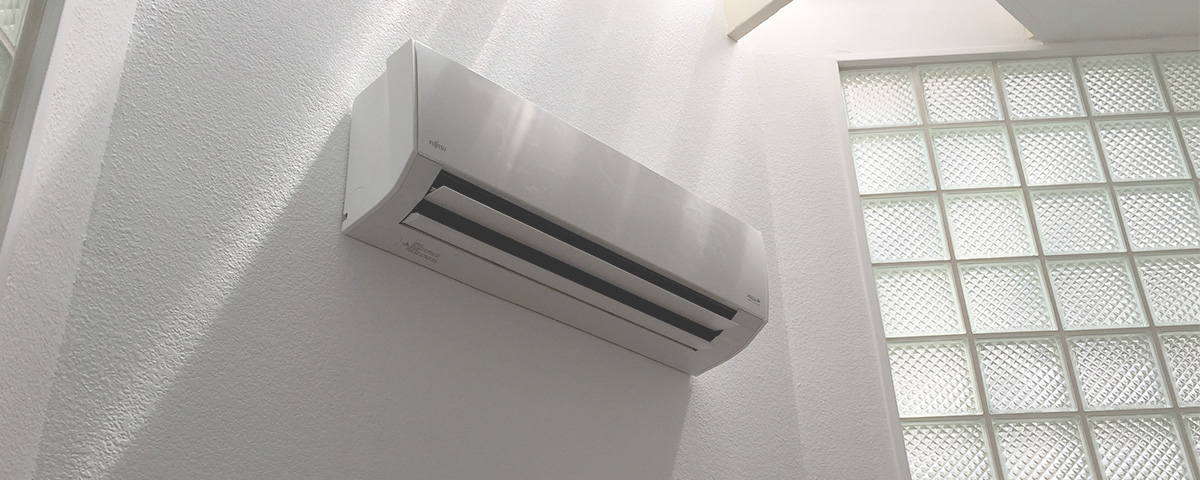In summer, air conditioners work to provide cooling and dehumidification. They extract heat from inside the home and transfer it outside. AC typically use a vapor compression cycle. This cycle circulates a refrigerant, a material that increases in temperature significantly when compressed and cools rapidly when expanded. The exterior portion of a typical AC is called the condensing unit and houses the compressor, the noisy part that uses most of the energy, and the condensing coil. An air-cooled condensing unit should be kept free from plants and debris that might block the flow of air through the coil or damage the thin fins of the coil. Ideally, the condensing unit should be located in the shade. However, do not block air flow to this unit with dense vegetation, fencing or overhead decking. The inside mechanical equipment, called the air-handling unit, houses the evaporator coil, the indoor blower, and the expansion, or throttling valve. The controls and ductwork for circulating cooled air to the house complete the system.
What is a ductless mini split air conditioner systems?

Mini split systems have no ducts. They have two main components, an outdoor compressor and an indoor air-handling unit. The two units are linked by a conduit which stores the power cable, suction tubing, refrigerant tubing and a condensate drain. Indoor units can be wall or ceiling mounted. Ductless splits can be used to cool one zone or multiple zones applying two to four indoor units to one condenser. The indoor units can all be used independently of each other.
How to Choose a Ductless Split Air Conditioner: A Practical Guide
Choosing the right ductless split air conditioner, also known as a mini-split, can greatly improve your indoor comfort, energy efficiency, and even long-term cost savings. With so many options on the market, selecting the right system might feel overwhelming. This guide breaks down the key factors to consider when choosing a ductless split air conditioner for your home or business.
- Determine Your Cooling (and Heating) Needs. Start by identifying the square footage of the space you want to condition. Ductless mini-splits are available in a range of capacities, usually measured in BTUs (British Thermal Units). See BTU chart based on room size.
- Choose Between Single-Zone and Multi-Zone Systems.
- Single-Zone Systems: Best for conditioning a single room or isolated space.
- Multi-Zone Systems: Can connect one outdoor unit to 2–8 indoor units, ideal for whole-home or multi-room climate control.
- Check the Energy Efficiency Ratings. Look for systems with high SEER (Seasonal Energy Efficiency Ratio) and HSPF (Heating Seasonal Performance Factor) ratings.
- SEER: Higher SEER = better cooling efficiency. Look for a SEER rating of 16 or higher.
- HSPF: Relevant if your system will also heat. HSPF of 8 or higher is considered efficient.
- Consider the Type of Indoor Unit. Ductless indoor units come in several styles:
- Wall-Mounted: Most common and easiest to install.
- Ceiling Cassette: Recessed into the ceiling—great for commercial or modern designs.
- Floor-Mounted: Suitable for areas with limited wall space.
- Concealed Ducted: Hidden from view and connected to short duct runs.
- Look for Smart Features and Controls. Many mini-splits now come with Wi-Fi connectivity, smart thermostats, and mobile app control, allowing you to adjust settings remotely. These features enhance convenience and can help you manage energy use more effectively.
- Check Noise Levels. If quiet operation is important (e.g., for bedrooms or offices), compare the decibel (dB) ratings of different models. Many ductless systems operate as quietly as 19–30 dB-quieter than a whisper.
- Assess the Brand Reputation and Warranty. Stick with well-known, reliable brands like Mitsubishi, Daikin, Fujitsu, LG, or Panasonic. Look for:
- Comprehensive warranties (5–12 years is common)
- Local service availability
- Positive customer reviews and support
- Professional Installation Is a Must. Even if you're handy, ductless split systems should be installed by a licensed HVAC technician. Proper installation ensures:
- System performance and efficiency
- Manufacturer warranty validity
- Correct refrigerant charge and electrical setup
- Consider Climate Conditions. If you live in an area with harsh winters, make sure your system has low-temperature heating capabilities. Look for models labeled “Hyper-Heat” or “cold-climate mini-split” for reliable year-round performance.
- Budget Accordingly. Prices vary based on:
- System capacity
- Number of zones
- Indoor unit type
- Brand
- Installation complexity
Tip: Oversizing or undersizing your unit can lead to inefficiency, discomfort, or higher energy bills. A professional load calculation is ideal.
Tip: If you're planning to add more rooms in the future, opt for a system that supports expandability.
Energy Star–certified models typically offer excellent efficiency and long-term savings.
Choose the style that best fits your space, layout, and design preferences.
Expect to pay between $2,000–$5,000 for a single-zone system (installed), and $5,000–$12,000+ for multi-zone setups.
Where can mini-splits be used?
Mini-split systems - also known as ductless mini-splits - are incredibly versatile HVAC solutions that can be used in a wide variety of settings. Because they don’t require ductwork and can be independently controlled, they’re ideal for both residential and commercial applications. Mini-splits can be used almost anywhere you need effective, flexible, and efficient heating and cooling. Their ease of installation, zone control, and ability to work without ducts make them an excellent choice for a wide range of applications - from individual rooms to whole homes and commercial buildings. Whether you’re upgrading your comfort or planning a new space, mini-splits offer a smart solution tailored to your specific needs. Here are some of the most common (and effective) places to use mini-splits:
-
Homes Without Existing DuctworkOlder homes or historic buildings that were built before central HVAC systems became standard often lack ductwork. Installing a mini-split allows for heating and cooling without the need for costly renovations or tearing into walls.
-
Room Additions or RenovationsWhen you add a sunroom, garage conversion, or new room to your home, extending existing ductwork can be expensive or impractical. Mini-splits offer a simple, independent solution that can be installed quickly and without disrupting the rest of your HVAC system.
-
Apartments, Condos, and Multi-Family HomesIn multi-unit buildings, it’s often difficult to retrofit a central system for every tenant. Mini-splits allow for zoned comfort in each unit, giving residents control over their own temperature without interfering with their neighbors.
-
Basements and AtticsThese areas are notoriously hard to keep comfortable due to their insulation challenges and location in the home. Mini-splits provide focused heating and cooling without requiring a connection to your home’s central system.
-
Garages and WorkshopsIf you use your garage or workshop year-round, a mini-split is a great way to keep the space comfortable without conditioning the entire home. Plus, many mini-splits offer both heating and cooling, which is ideal for these multipurpose areas.
-
Home Offices and StudiosSpending long hours in a small space like a home office or art studio? A mini-split gives you precise control over the temperature, ensuring comfort and energy efficiency without adjusting the settings for the rest of the home.
-
Server Rooms or IT ClosetsSmall commercial spaces like server rooms or IT closets often require constant cooling. Mini-splits provide targeted climate control without compromising the comfort of the rest of the office.
-
Commercial SpacesRetail stores, restaurants, clinics, salons, and other commercial establishments benefit from the flexibility and zone control mini-splits offer. They can be installed in individual rooms, suites, or open-concept spaces without the need for extensive ductwork.
-
Vacation Homes and GuesthousesMini-splits are ideal for spaces that are used part-time or seasonally. You can turn them on only when needed, reducing energy waste and lowering utility bills compared to running a full HVAC system for an unoccupied space.
-
Energy-Efficient HomesIn homes designed to be energy-efficient or net-zero, mini-splits are a perfect match. They offer excellent performance with high SEER ratings and can be paired with renewable energy sources like solar panels for even greater efficiency.
| BTU chart based on room size | |
|---|---|
| Area (ft²) | BTU's Required |
| 100 to 150 | 5,000 BTUs |
| 150 to 250 | 6,000 BTUs |
| 250 to 300 | 7,000 BTUs |
| 300 to 350 | 8,000 BTUs |
| 350 to 400 | 9,000 BTUs |
| 400 to 450 | 10,000 BTUs |
| 450 to 550 | 12,000 BTUs |
| 550 to 700 | 14,000 BTUs |
| 700 to 1,000 | 18,000 BTUs |
| 1,000 to 1,200 | 21,000 BTUs |
| 1,200 to 1,400 | 23,000 BTUs |
| 1,400 to 1,500 | 24,000 BTUs |
| 1,500 to 2,000 | 30,000 BTUs |
| 2,000 to 2,500 | 34,000 BTUs |
| Add 20% BTUs for ceilings higher than 8 ft. and poorly insulated areas | |
| Add 30% BTUs for climates with seasonal temperatures over 90℉ | |
Multi zone ductless mini split system.
The Ductless Multi-Zone Mini Split Air Conditioners allow you to enjoy ideal levels of comfort in the rooms you use most. Each room (zone) operates independently with its wireless/wired remote control. People in different rooms – the kitchen, master bedroom, or living room – can enjoy temperature settings that make each room most comfortable. Plus, you have the option of not heating or cooling rooms that are not being used. If you’re looking for a complete comfort solution for several different rooms, the multi-zone system is the right choice. The system is flexible enough to conform to a particular cooling and heating need and offers numerous different indoor unit combinations.
Advantages of Ductless Air Conditioners
Multi-split systems run on small pipes that require a mere three-inch hole. That means homeowners don’t have to worry about rebuilding walls or ceilings around ductwork and there is no loss of precious square footage.
